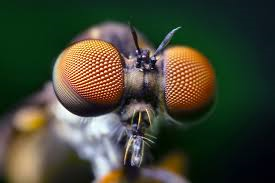Neurologie, evolutie: oog Het
bestaan van een ingewikkelde constructie als het menselijke oog wordt frequent
aangehaald als bewijs van een vorm van "intelligent design": iemand moet
dat zo in elkaar gezet hebben om als geheel te kunnen functioneren. Het is
tevens een klassiek geval van onwetendheid, want de evolutie van het menselijke
oog is in detail bekend. Ook bekend is dat het menselijke oog één van de
eindlijnen is van de vele malen dat een "oog"-functie en -constructie door de
natuur is geëvolueerd, een ander voorbeeld zijnde het facet-oog van insecten,
zie de afbeelding rechts(boven), afkomstig van deze website Het
bestaan van een ingewikkelde constructie als het menselijke oog wordt frequent
aangehaald als bewijs van een vorm van "intelligent design": iemand moet
dat zo in elkaar gezet hebben om als geheel te kunnen functioneren. Het is
tevens een klassiek geval van onwetendheid, want de evolutie van het menselijke
oog is in detail bekend. Ook bekend is dat het menselijke oog één van de
eindlijnen is van de vele malen dat een "oog"-functie en -constructie door de
natuur is geëvolueerd, een ander voorbeeld zijnde het facet-oog van insecten,
zie de afbeelding rechts(boven), afkomstig van deze website
Onderstaand een artikel dat gaat over de ontwikkeling van het oog bij weekdieren - specifiek de mossel. Het kan direct overgenomen worden als model voor de ontwikkeling van het menselijke oog. Weggelaten uit deze bron zijn de allereerste stappen. Die zijn dat heel veel moleculen die op een voor het leven geschikte manier manier in elkaar zitten, stabiel maar toch plooibaar, gevoelig zijn voor licht. Licht bestaat uit fotonen bij een bepaalde kleur een bepaalde hoeveelheid energie, en als het betreffende molecuul precies die hoeveelheid energie kan absorberen, kunnen er drie dingen gebeuren: het molecuul kan de energie doorgeven aan naburige moleculen, het molecuul kan sneller gaan bewegen of trillen, of, als gevolg van het tweede: het kan uit elkaar vallen. De eerste twee gebeurt met moleculen in cellen als er sprake is van fotosynthese. Er zijn al eencelligen die gebruik maken van fotosynthese. Het derde kan gezien worden als schade - het verschijnsel is onder andere bekend als "het verkleuren van een afbeelding onder zonlicht" omdat de moleculen die de afbeelding kleur geven, door het licht, meestal de ultraviolette variant, uit elkaar vallen. Het is volstrekt helder dat dit proces ook gebruikt kan worden voor het detecteren van licht. Binnen een meercellige structuur kan specialisatie optreden naar cellen wier functie het is om gevoelig te zijn voor licht. Iets dat in de natuur duidelijk een evolutionair voordeel vormt ten opzichte van structuren die dat niet hebben. Dan is "meerdere cellen" een voordeel ten opzichte van "één cel" (meer gevoeligheid). Waarna die meerdere cellen eigen structuren kunnen gaan vormen om het proces te verfijnen. Op dat ontwikkelingspunt start de bron (www.weichttiere.at  ): ):
Kortom: het ontstaan van het oog is zo logisch als het maar kan, als je het maar ziet in zijn juiste perspectief, dat wil zeggen: met de juiste tussenstappen. Hier geldt een adagium van sciencefictionauteur Jack Vance Naar Neurologie, organisatie
|
